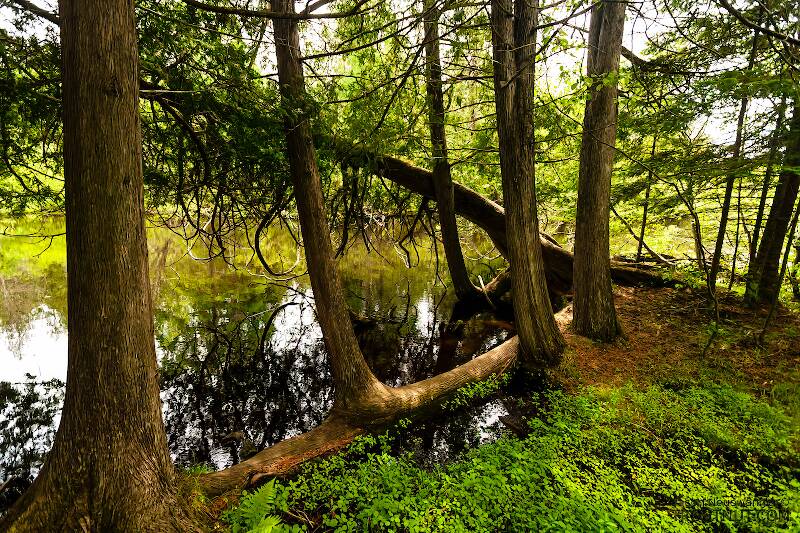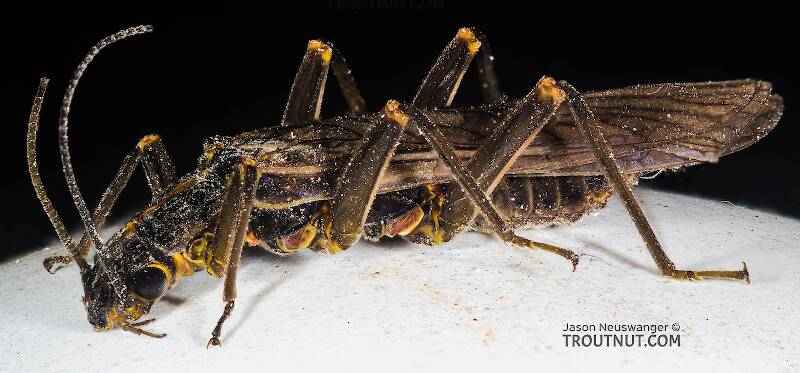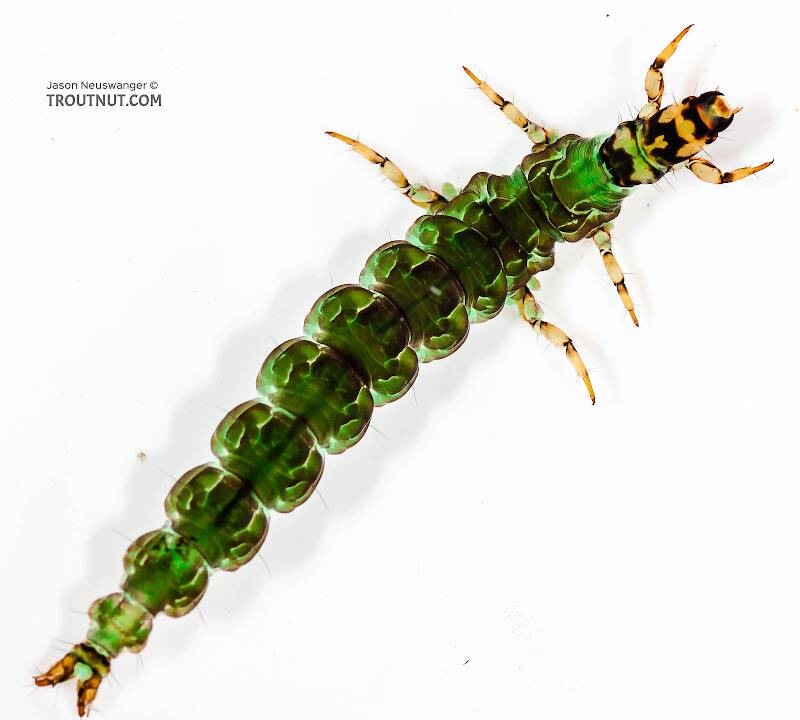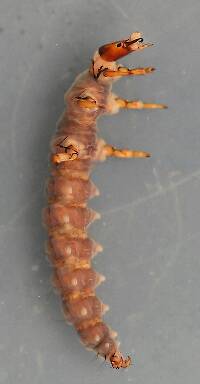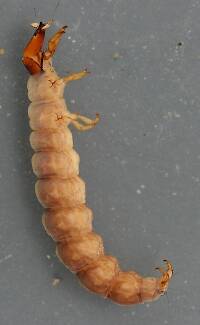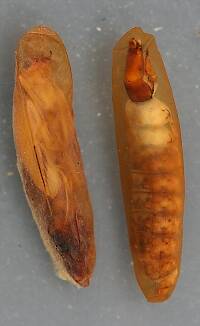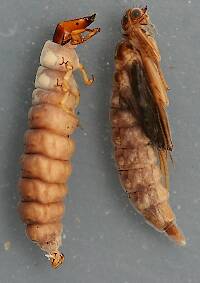
Hex Mayflies
Hexagenia limbata
The famous nocturnal Hex hatch of the Midwest (and a few other lucky locations) stirs to the surface mythically large brown trout that only touch streamers for the rest of the year.
Featured on the forum

Troutnut is a project started in 2003 by salmonid ecologist Jason "Troutnut" Neuswanger to help anglers and
fly tyers unabashedly embrace the entomological side of the sport. Learn more about Troutnut or
support the project for an enhanced experience here.
Herefishy on Apr 7, 2007April 7th, 2007, 8:37 am EDT
I'm new to flyfishing and the art/ science of insect identification.
This caddis larvae is also known as a hellgramite- correct? Is a caddis larvae and a caddisfly the same? Are there any simple books out there that will help me get started with realy understanding the food that trout eat?
This caddis larvae is also known as a hellgramite- correct? Is a caddis larvae and a caddisfly the same? Are there any simple books out there that will help me get started with realy understanding the food that trout eat?
Troutnut on Apr 7, 2007April 7th, 2007, 9:00 am EDT
Caddisflies / caddis larvae are very different creatures from hellgrammites. Hellgrammites are in a different order, Megaloptera, and you can read about them through this link.
Caddis larvae are one stage of caddisflies. I guess the way we use the terms can be a little confusing. When we say caddisflies, we sometimes just mean the winged adults, but often we're talking about any stage of the critter (larva, pupa, or adult).
To use an SAT-test-like analogy, "caddis larva" is to "caddisfly" as "baby" is to "person."
There are lots of simple books out there, but browsing this site is a good start too.
Caddis larvae are one stage of caddisflies. I guess the way we use the terms can be a little confusing. When we say caddisflies, we sometimes just mean the winged adults, but often we're talking about any stage of the critter (larva, pupa, or adult).
To use an SAT-test-like analogy, "caddis larva" is to "caddisfly" as "baby" is to "person."
There are lots of simple books out there, but browsing this site is a good start too.
Jason Neuswanger, Ph.D.
Troutnut and salmonid ecologist
Troutnut and salmonid ecologist
GONZO on Apr 7, 2007April 7th, 2007, 10:43 am EDT
Herefishy-
Gary Borger's Naturals: A Guide to Food Organisms of the Trout might be a good place to start. If you'd like something a little more recent and with an Eastern orientation, Thomas Ames' Hatch Guide for New England Streams is good. Borger's book covers a broader range of trout foods, but Ames' book is more specific and has great photographs.
Jason's right, though, this site is a great place to find information--as long as you're not afraid to ask.
-Gonzo
Gary Borger's Naturals: A Guide to Food Organisms of the Trout might be a good place to start. If you'd like something a little more recent and with an Eastern orientation, Thomas Ames' Hatch Guide for New England Streams is good. Borger's book covers a broader range of trout foods, but Ames' book is more specific and has great photographs.
Jason's right, though, this site is a great place to find information--as long as you're not afraid to ask.
-Gonzo
Earlfishman
Posts: 17
Posts: 17
Earlfishman on Apr 12, 2007April 12th, 2007, 5:27 am EDT
Your Rhyacophila is R. fuscula, a very common eastern species. Typically call Green Rockworms, this family of Trichoptera are predominantly predatory.
Earl
Earl
Quillgordon on Apr 12, 2007April 12th, 2007, 6:53 am EDT
Earl,
Just curious ....... how did you determine the exact species of this caddis ?
I'm a novice here...... just trying to learn the 'ropes', as my father would say!
Just curious.....
John
Just curious ....... how did you determine the exact species of this caddis ?
I'm a novice here...... just trying to learn the 'ropes', as my father would say!
Just curious.....
John
Flyfishing is a state of mind! .............. Q.g.
C/R........barbless
C/R........barbless
GONZO on Apr 12, 2007April 12th, 2007, 7:06 am EDT
Earl,
I thought that this might be fuscula as well, but I wasn't sure I could justify it based on the keys I had access to. Was the ID based primarily on the configuration of the prolegs (the long curved apicolateral spurs), or were there other characters that you used to confirm?
I thought that this might be fuscula as well, but I wasn't sure I could justify it based on the keys I had access to. Was the ID based primarily on the configuration of the prolegs (the long curved apicolateral spurs), or were there other characters that you used to confirm?
GONZO on Apr 12, 2007April 12th, 2007, 5:53 pm EDT
John,
There are a number of folks lurking on this site with excellent biological/entomological credentials--DMM, Konchu, Litobrancha, and I'm starting to suspect Earl. ;)
Those folks are much better at this than I am, but they are also busy guys (unlike me at the moment). So I'll take a stab at giving you a little help on this one. Green rockworms or green sedge larvae are pretty easy to recognize at the genus level (Rhyacophila). They are fairly large, very common free-living larvae that are usually a pretty intense green with bulges at the segments of the abdomen.
About the only other common "caseless" larvae that you're likely to confuse them with are some of the larger net-spinners of Hydropsychidae. These spotted sedge larvae are usually more olive brown or brownish, but they also have three darkened dorsal thoracic segments (plates) behind the head and a fairly obvious brush of hairs at the end of the abdomen.
As for nailing the larvae down to species, this is often more difficult and either requires a lot of experience with the species in question or rigorous scientific keys. These keys are usually in the form of a long series of couplets that allow you to gradually narrow the possibilities. The problem for most laymen when using the keys is that you have to wade through some pretty confusing jargon in order to understand them. The scientists don't use jargon just to confuse us (though it sometimes seems that way); these are really very precise terms with very specific meanings--to avoid confusion.
In the case of this specimen, which Litobrancha has also confirmed as fuscula, I believe that the key trait is probably the long curving slender hooks (spurs) that you see next to the heavier claws on the little "false legs" at the rear of the abdomen. The finer distinguishing traits that permit species identification sometimes require the use of significant magnification (and even then it may not be possible, depending on the specimen). But, Jason's excellent photographs often perform that task for us, making it much easier.
I hope that my lame layman's explanation helps a bit, and I also hope that I didn't mess up the explanation too badly. Much of the basic information that will lead to a genus level ID can often be gleaned from Jason's excellent descriptions that accompany his photos.
Best wishes from a fellow amateur,
Gonzo (Lloyd)
There are a number of folks lurking on this site with excellent biological/entomological credentials--DMM, Konchu, Litobrancha, and I'm starting to suspect Earl. ;)
Those folks are much better at this than I am, but they are also busy guys (unlike me at the moment). So I'll take a stab at giving you a little help on this one. Green rockworms or green sedge larvae are pretty easy to recognize at the genus level (Rhyacophila). They are fairly large, very common free-living larvae that are usually a pretty intense green with bulges at the segments of the abdomen.
About the only other common "caseless" larvae that you're likely to confuse them with are some of the larger net-spinners of Hydropsychidae. These spotted sedge larvae are usually more olive brown or brownish, but they also have three darkened dorsal thoracic segments (plates) behind the head and a fairly obvious brush of hairs at the end of the abdomen.
As for nailing the larvae down to species, this is often more difficult and either requires a lot of experience with the species in question or rigorous scientific keys. These keys are usually in the form of a long series of couplets that allow you to gradually narrow the possibilities. The problem for most laymen when using the keys is that you have to wade through some pretty confusing jargon in order to understand them. The scientists don't use jargon just to confuse us (though it sometimes seems that way); these are really very precise terms with very specific meanings--to avoid confusion.
In the case of this specimen, which Litobrancha has also confirmed as fuscula, I believe that the key trait is probably the long curving slender hooks (spurs) that you see next to the heavier claws on the little "false legs" at the rear of the abdomen. The finer distinguishing traits that permit species identification sometimes require the use of significant magnification (and even then it may not be possible, depending on the specimen). But, Jason's excellent photographs often perform that task for us, making it much easier.
I hope that my lame layman's explanation helps a bit, and I also hope that I didn't mess up the explanation too badly. Much of the basic information that will lead to a genus level ID can often be gleaned from Jason's excellent descriptions that accompany his photos.
Best wishes from a fellow amateur,
Gonzo (Lloyd)
Troutnut on Apr 12, 2007April 12th, 2007, 6:00 pm EDT
I'm also curious as to how people Earl and Litobrancha, who both identified this one as R. fuscula, ruled out the other 137 (!!!!) species of Rhyacophila. I know it can be easy to do that just by eyeballing taxa you know really well, especially when most of the other species are obscure and local. But I'm very curious about the distinguishing features for this one.
Jason Neuswanger, Ph.D.
Troutnut and salmonid ecologist
Troutnut and salmonid ecologist
PeterO
Posts: 8
Posts: 8
PeterO on Apr 14, 2007April 14th, 2007, 7:29 am EDT
Gonzo-
Your stab at identifying R. fuscula is right on. The apical spurs on the prolegs are one of the characters leading to the determination. Head pattern and the presence of teeth on the anal claws are others. There are a handful of eastern Rhyacophila species with apical spurs however, so be careful with field ID's. Happy IDing.
BTW- how the heck do you get italics in your post?
PeterO
Your stab at identifying R. fuscula is right on. The apical spurs on the prolegs are one of the characters leading to the determination. Head pattern and the presence of teeth on the anal claws are others. There are a handful of eastern Rhyacophila species with apical spurs however, so be careful with field ID's. Happy IDing.
BTW- how the heck do you get italics in your post?
PeterO
GONZO on Apr 14, 2007April 14th, 2007, 9:38 am EDT
PeterO,
Thanks for the confirmation of those characters. I also knew about the head pattern, although the only key I could locate describes anterior and posterior "bands" on the frontoclypeus, so I wasn't sure about interpretation. Irregular dark bars on the head is the way I see it.
If you don't mind me asking, which Eastern species (other than fuscula and mainensis, with which I am familiar) have the apicolateral spurs? I'll trade that info for the italics secret: Type these brackets [] around an "i" before the text you want to italicize and the same brackets containing "/i" after the text. These and other mysterious secret instructions are contained in Jason's "formatting" info. (But, I had to ask, so don't feel bad!) ;)
Thanks for the confirmation of those characters. I also knew about the head pattern, although the only key I could locate describes anterior and posterior "bands" on the frontoclypeus, so I wasn't sure about interpretation. Irregular dark bars on the head is the way I see it.
If you don't mind me asking, which Eastern species (other than fuscula and mainensis, with which I am familiar) have the apicolateral spurs? I'll trade that info for the italics secret: Type these brackets [] around an "i" before the text you want to italicize and the same brackets containing "/i" after the text. These and other mysterious secret instructions are contained in Jason's "formatting" info. (But, I had to ask, so don't feel bad!) ;)
Troutnut on Apr 14, 2007April 14th, 2007, 3:32 pm EDT
Hey Peter,
Thanks for the ID information. Here are the directions on formatting your text:
http://www.troutnut.com/forumcode
Thanks for the ID information. Here are the directions on formatting your text:
http://www.troutnut.com/forumcode
Jason Neuswanger, Ph.D.
Troutnut and salmonid ecologist
Troutnut and salmonid ecologist
PeterO
Posts: 8
Posts: 8
PeterO on Apr 18, 2007April 18th, 2007, 4:07 am EDT
Gonzo-
Currently, there are six species in the east with apicodorsal spurs on the anal proleg. Three of which, formosa, mainensis, and amicis have the spur short and sharply decurved. Mainensis and amicis are inseparable as larva. The remaining three: atrata, angelita, and fuscula have the long and relatively straight spur. There are still approximately 8 species in the east that are unknown as larvae. Hope this helps and thanks for the formatting info...not that I used it.
Currently, there are six species in the east with apicodorsal spurs on the anal proleg. Three of which, formosa, mainensis, and amicis have the spur short and sharply decurved. Mainensis and amicis are inseparable as larva. The remaining three: atrata, angelita, and fuscula have the long and relatively straight spur. There are still approximately 8 species in the east that are unknown as larvae. Hope this helps and thanks for the formatting info...not that I used it.
GONZO on Apr 18, 2007April 18th, 2007, 4:47 am EDT
PeterO,
Thanks for the additional info. I didn't know about the amicis "twin" when I identified another of Jason's Rhyacophila specimens as mainensis. So I suppose that ID should be revised to R. mainensis or amicis.
Thanks for the additional info. I didn't know about the amicis "twin" when I identified another of Jason's Rhyacophila specimens as mainensis. So I suppose that ID should be revised to R. mainensis or amicis.
Riverratben on Apr 20, 2007April 20th, 2007, 3:54 pm EDT
What are some aquatic insects, other than helgermites, that you have out east that we do not have in the western US?
Skwalla?
Yellow Sally?
Glossosoma?
Alderfly?
Water boatman?
Just Curious.
Skwalla?
Yellow Sally?
Glossosoma?
Alderfly?
Water boatman?
Just Curious.
SEVERELY ADDICTED!
Taxon on Apr 20, 2007April 20th, 2007, 6:27 pm EDT
What are some aquatic insects, other than helgermites, that you have out east that we do not have in the western US?
Skwalla?
Yellow Sally?
Glossosoma?
Alderfly?
Water boatman?
Just Curious.
Ben-
I’m confused by your question, as you have all of the insects you mentioned in Colorado.
Riverratben on Apr 21, 2007April 21st, 2007, 7:52 am EDT
What I meant by that is do you have the following bugs out east, sorry.
Do you have Skwallas, yellow sally's, waterboatman,ect.
Obviously I need to start reading what I write to see if it makes sense.
Do you have Skwallas, yellow sally's, waterboatman,ect.
Obviously I need to start reading what I write to see if it makes sense.
SEVERELY ADDICTED!
Taxon on Apr 21, 2007April 21st, 2007, 9:40 am EDT
Ben-
Skwala is a genus of stoneflies whose distribution is limited to the western states.
Yellow Sally is a common name for genus Isoperla stoneflies, whose distribution is widely distributed and includes eastern states.
Glossosoma is a genus of caddisflies, the vast majority of whose (22) N. American species are limited to western states, except for G. intermedium, which are also present in mid-western and eastern states, and G. nigrior, whose distribution is limited to mid-western and eastern states, and G. lividum and G. spinatum, whose distribution is limited to eastern states.
Alderflies have a single N. American genus, Sialis, which has widespread distribution.
Water boatmen have (18) N. American genera, whose distribution tend to be somewhat localized to specific geographic regions or states (North, Northwest, Florida, Texas, West, Southwest, etc.), with only three genera, Hesperocorixa, Sigara, and Trichocorixa being distributed across all N. American geographic regions.
Skwalla?
Yellow Sally?
Glossosoma?
Alderfly?
Water boatman?
Skwala is a genus of stoneflies whose distribution is limited to the western states.
Yellow Sally is a common name for genus Isoperla stoneflies, whose distribution is widely distributed and includes eastern states.
Glossosoma is a genus of caddisflies, the vast majority of whose (22) N. American species are limited to western states, except for G. intermedium, which are also present in mid-western and eastern states, and G. nigrior, whose distribution is limited to mid-western and eastern states, and G. lividum and G. spinatum, whose distribution is limited to eastern states.
Alderflies have a single N. American genus, Sialis, which has widespread distribution.
Water boatmen have (18) N. American genera, whose distribution tend to be somewhat localized to specific geographic regions or states (North, Northwest, Florida, Texas, West, Southwest, etc.), with only three genera, Hesperocorixa, Sigara, and Trichocorixa being distributed across all N. American geographic regions.
Riverratben on Apr 21, 2007April 21st, 2007, 11:52 am EDT
Wow thanks Taxon! That is a huge help.
I really appreciate the help.
Ben
I really appreciate the help.
Ben
SEVERELY ADDICTED!
Taxon on Apr 21, 2007April 21st, 2007, 3:01 pm EDT
No problem, Ben. That's all I do; just ask my wife.
Acroneuria on May 30, 2007May 30th, 2007, 2:26 am EDT
No, Helgrammites, AKA Dobsonflys, are of the Corydalidae family, Megaloptera order--not at all related to Caddisflies. Caddisflies belong to the Trichoptera order. A Caddisfly larvae is a Caddisfly, but the immature larval/aquatic stage. The fly stage is considered the adult stage.
This Rhycophila f. picture is of a larvae.
Trout are opportunistic feeders; they'll eat almost anything that is most in abundance/available.
This Rhycophila f. picture is of a larvae.
Trout are opportunistic feeders; they'll eat almost anything that is most in abundance/available.
Water Pollution Biologist
PA Department of Environmental Protection
PA Department of Environmental Protection
Quick Reply
Related Discussions
Topic
Replies
Last Reply
0
Apr 12, 2007
by Litobrancha
by Litobrancha
2
Nov 26, 2007
by FlyDoc
by FlyDoc
1
Sep 5, 2006
by Troutnut
by Troutnut

